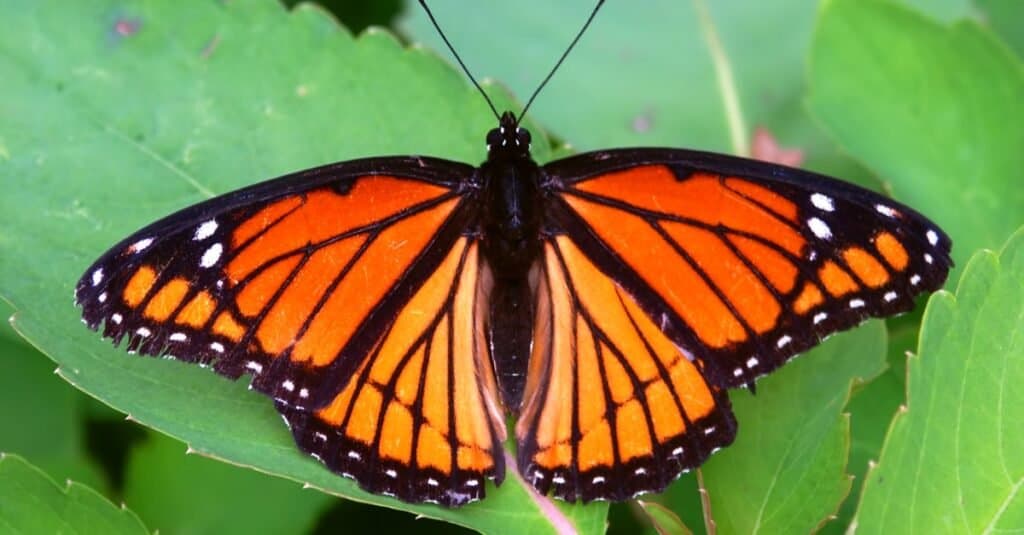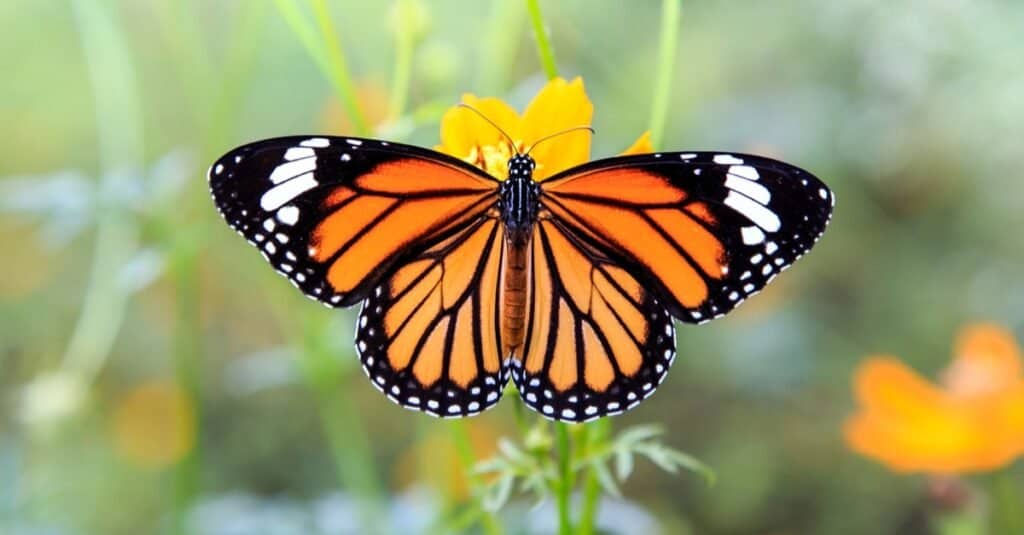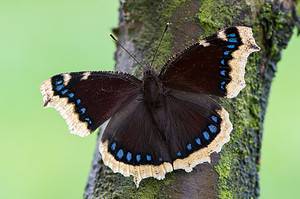The monarch butterfly and the viceroy butterfly look very much alike, but there are several differences as well as similarities. The monarch is considered a milkweed butterfly in that its caterpillar’s host plant is the milkweed. Because the caterpillar eats the milkweed, which is full of toxins, the monarch butterfly is poisonous. The bold orange and black colors on its wings warn potential predators of the fact, and a bird who takes a bite out of a hind wing learns not to attack a butterfly that looks like it again. Read on to discover what is the differences when Viceroy Butterfly vs Monarch Butterfly are compared.
The host plants of the viceroy caterpillar are often willows, aspens, and poplar trees. Willow trees in particular contain salicylic acid, which is a precursor of aspirin. The caterpillar collects the acid, and it persists in the body of the viceroy butterfly. When some predator has at it, the salicylic acid, as too much aspirin will, upsets its stomach. Thus, the colors of the viceroy are considered a type of Müllerian mimicry. This is when two bad-tasting or poisonous creatures mimic each other’s coloration or other attributes. Read on to learn more about the viceroy and monarch butterflies.

©Jason Patrick Ross/Shutterstock.com
Monarch vs Viceroy: Colors
One of the similarities between the viceroy and the monarch is the colors and patterns on their wings. They are so alike that it is very hard to tell them apart at a glance. The veins in the wings have dark borders, and there are white spots at the borders of both the forewings and the hindwings. What is different is the wings of the viceroy butterfly are more scalloped at the edges, and instead of three orange patches at the top edge of the forewings the viceroy has four. The edges of the underside of the forewings also tend to be paler in the viceroy.
But what really differentiates the butterflies is the black line that crosses the veins in both hindwings. The monarch lacks this line.
Monarch vs Viceroy: Flight
If you look closely, you’ll notice that the flight patterns of viceroys and monarchs are also a little different. Monarchs soar and hold their wings in a V shape, while viceroys flap their wings more and hold their wings more in a straight line, like the difference between the turkey vulture and the black vulture.
Monarch vs Viceroy: Size
Another of the differences between the viceroy and the monarch is their size. The viceroy is a smaller butterfly, with a 2.25 to 3-inch wingspan. The monarch is larger, and its wingspan is 3 to 4 inches wide. Indeed, the viceroy gets its name precisely because it is smaller than the monarch.
Monarch vs Viceroy: Range
The viceroy’s range is from Canada down through the United States and into Mexico. Unlike it’s counterpart, the viceroy does not migrate. Caterpillars in their 1st or 2nd stage will hibernate.
The monarch, though native to the Americas, has spread to Oceania, Indonesia, and the Mediterranean countries. It is famous for its multigenerational migrations. Every fall, nearly 3,000 monarchs migrate from the northeastern states in North America to Mexico. Amazingly, monarchs know how to do this based on instinct. Each migration group is a new generation, so they have not been taught by others.
Monarch vs Viceroy: Host Plants
The monarch butterfly is one of the types of milkweed butterflies. These are butterflies whose caterpillars feed on milkweed plants, and their mothers are careful to lay their eggs on these plants. The ingestion of the leaves makes both the caterpillars and the butterflies poisonous. This not only protects them but protects butterflies that look like them from predation. For a time scientists weren’t sure if the viceroy, which is actually one of the types of admiral butterflies, was employing Batesian mimicry or Müllerian mimicry. In the former, the butterfly would be harmless but takes on the warning colors of the monarch. In the latter, the butterfly has the same type of coloration but is itself poisonous. One of the similarities the monarch and viceroy share is that birds are their main predators, and experiments have found that birds find both the viceroy and the monarch just about equally unpalatable. This is because the viceroy caterpillar takes in salicylic acid from its willow host plant instead of the cardiac glycosides found in milkweeds.
Monarch vs Viceroy: Food Plants
Both the monarch and the viceroy nectar from milkweed plants. The monarch also takes nectar from the butterfly bush, the ironweed, the mallow, thistles, wormwood, and mint. The viceroy takes nectar from asters, butterfly bushes, thistles, goldenrods, and others. Later in the season, it will sip moisture from ripe fruit and honeydew from aphids. Like its caterpillar, it is not above ingesting feces and carrion. This practice is not all that different from the food habits of many other types of butterflies. These food items, distasteful as they are to humans, provide the insect with salt and other nutrients.

©CHAINFOTO24/Shutterstock.com
Monarch vs Viceroy: Reproduction
Viceroys mate in the afternoon, and the female lays one egg on a leaf that hasn’t been chewed on by another insect. Viceroys may breed all year long in the warmer parts of their range. Monarchs mate just before they come back from their winter home. Mating happens after the male has pinned the female to the ground. When she finally gets back to her breeding ground, the female deposits her eggs on milkweed plants.
Caterpillar
The greatest differences between the monarch butterfly and the viceroy butterfly are probably found in their caterpillars. The caterpillars already have different host plants, but they also look very different. Frankly, the viceroy’s caterpillar looks like a bird dropping. It is found, as is its host plant, in wet environments. The viceroy usually breeds three times a year, and the first batch of caterpillars may actually eat dung, carrion, and rotting mushrooms. At its largest, it is 2 inches long. The caterpillar hides in a rolled leaf to spend the winter, then weaves a chrysalis that also looks like a bird dropping. It hangs from a blade of grass or twig.
If a caterpillar can ever be said to be beautiful, it is the caterpillar of the monarch butterfly. It is not only beautiful but can be told from every other caterpillar. It is striped in white, yellow, and black from front to back and bears black filaments on the area just behind its head to its rear end. It is found in a variety of habitats, as is milkweed. These include gardens, abandoned lots, pastures, and meadows. Like the viceroy caterpillar, the monarch caterpillar grows about 2 inches long.
Even the chrysalis of the monarch butterfly is beautiful. it is a pale jade green with fine black lines and gold spots. Just before the butterfly emerges, the chrysalis transforms into the orange, black, and white of the butterfly’s wings.
More Things to Know
Despite their similarities in looks, the viceroy and the monarch butterflies are not very closely related. The viceroy is the state butterfly of Kentucky. The admittedly more popular monarch is the state butterfly of Minnesota, Vermont, Texas, West Virginia, Alabama, Illinois, and Idaho.
Up Next…
Butterfly enthusiast? Here are some cool facts and ways to decipher them from moths.
- Amazing Things You Need To Know About Monarch Butterfly Caterpillar
- How Many Legs Does A Butterfly Have? Let’s Find Out!
- Moth vs Butterfly: The 8 Key Differences
The photo featured at the top of this post is © Sari ONeal/Shutterstock.com
Thank you for reading! Have some feedback for us? Contact the AZ Animals editorial team.






